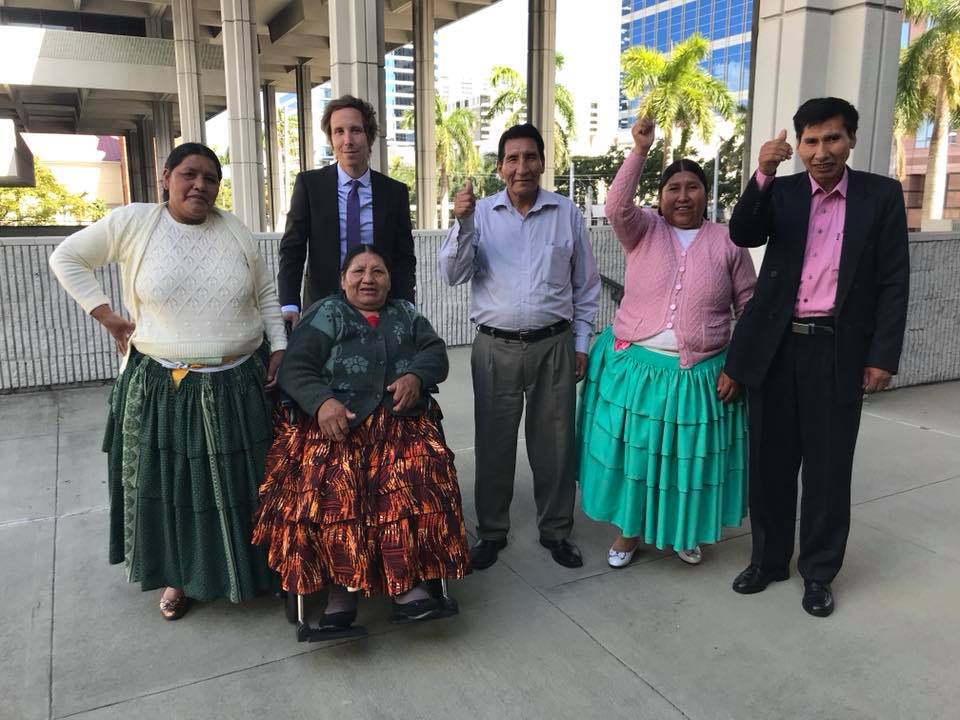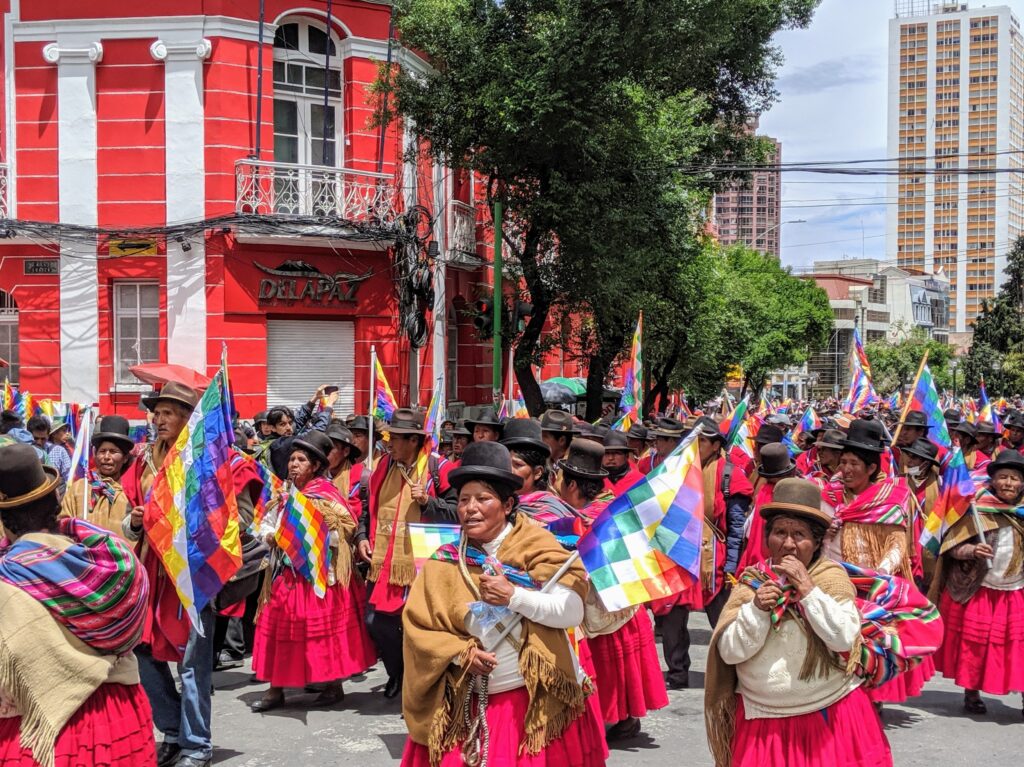Twenty years after massacre of indigenous Bolivians, the International Human Rights Clinic and its partners settle case that secured accountability for killings
October 2, 2023
In 2007, Harvard Law School’s International Human Rights Clinic filed a groundbreaking human rights suit in U.S. federal court against the former president of Bolivia and his minister of defense, seeking justice on behalf of Bolivian citizens whose families were killed by the military in 2003. The Clinic and its students have been involved in all facets of the litigation, from case construction and motion practice, to discovery and depositions, to multiple appeals, as well as a landmark trial in 2018.
After sixteen years of litigation, the parties reached a settlement last week. We spoke with Clinic Director Susan Farbstein to understand the significance of the case to the plaintiffs and the communities they represent, as well as to those working around the world to secure accountability and remedies for gross violations of human rights.
Q: To start, can you tell us what the Mamani case is about?

The case dates back to events that happened exactly 20 years ago in Bolivia, during a period that came to be known as “Black October.” The Bolivian government unleashed lethal force against unarmed Bolivian civilians, largely from the country’s indigenous Aymara community, to suppress popular protests against the government’s plan to export natural gas. Over a period of several weeks, the military killed dozens and injured hundreds of civilians, including family members of our clients—among them an eight-year-old girl shot and killed in her own home; a pregnant mother shot and killed inside her sister’s house; an elderly man shot and killed while walking home; another man shot and killed while tending his crops.
The Bolivian president at that time, Gonzalo Sánchez de Lozada, who everyone refers to as “Goni,” and his defense minister, José Carlos Sánchez Berzaín, fled to the United States and have lived here ever since. So our Clinic, along with attorneys from the Center for Constitutional Rights and the law firm of Akin Gump, brought suit under a federal statute called the Torture Victim Protection Act to hold these men accountable for their role planning and overseeing the killings.
In 2018, the case finally went to trial before a federal jury in Florida. After three weeks of testimony and a week of deliberation, the jury found the defendants responsible for the killings and awarded our plaintiffs $10 million in damages. It was really a landmark trial—the first time in history that a former head of state faced his accusers in a U.S. court for human rights violations—and a huge victory.
The case has been tied up in appeals ever since. About a month after the trial, the district court set aside the jury verdict, a decision that we appealed. The Eleventh Circuit vacated the district court’s decision and sent the case back down for further proceedings. The trial court then reinstated the verdict in our favor, finding that we had indeed presented sufficient evidence at trial that the deaths were extrajudicial killings under international law and that the defendants could be held responsible for those killings under the doctrine of command responsibility. The defendants were in the process of appealing that decision, and the plaintiffs were preparing for a new trial on some of our claims, until the case settled last week.

Q: Why is this settlement important?
From my perspective what’s important is, first, that the jury verdict holding the defendants liable for these killings is preserved. That verdict, and the evidence that was produced at trial, will always be part of the story of Black October. For anyone who wants to study or talk or write about what happened in Bolivia in 2003, their understanding of that history will be informed by this case.
Second, the case has sent an incredibly powerful message that even if you have survived abuse, that even if you come from a marginalized community that has historically held little political or economic power, it’s still possible to get accountability for gross human rights violations. The defendants may have thought that when they fled to the United States they were fleeing from justice. Our plaintiffs wouldn’t let that happen. Their courage and their perseverance really can’t be overstated. They weren’t afraid to take on two extremely powerful men, and they’ve shown not just Bolivia but really the whole world that justice in these kinds of circumstances is possible.
In terms of the settlement itself, it represents closure and finality for our clients. They will finally receive financial compensation from the defendants. It’s been twenty years since their loved ones were killed, sixteen years since we filed the suit, and five years since we won at trial. That is a very long time to continue to fight for justice, to keep your wounds open and be asked to re-tell your story or re-live the past. The former president is now a very old man—I believe he is 93 years old. I think many of the plaintiffs wanted a sense of closure and accountability before he passes away, and now they have it.
Q: What has it been like to work on this case for the past 15 years, for you and your students in the International Human Rights Clinic?
It’s really hard to capture how much this case has meant to me and the many students who have worked on it over the years—by my count, more than 40 students in total. Mamani has always been a part of my work here because it was filed a few months before I started at the Clinic. At that point I was less than four years out of law school, so just having the opportunity to contribute to a case of this magnitude felt incredibly exciting.
Over time, of course you become much more invested in the case—emotionally invested—and it becomes very personal. Especially as you really get to know the plaintiffs over a number of years, you meet with them in their homes or hike with them to visit the locations where their loved ones were killed, you come to feel an incredible amount of responsibility. Sometimes that feeling can fuel the work, and sometimes it can be almost daunting or overwhelming.
I really feel like I “grew up” as a human rights practitioner through this case—not just as a litigator, but more in terms of developing my own understanding of how to be a thoughtful and effective advocate, what it takes to achieve structural change and shift power dynamics rather than just attack symptoms, and how to center the clients and their needs and perspective so that you’re driven by their vision of justice. More than any technical legal skill, that’s what I’ve tried to teach my students through this case.
Those students—now alumni—who worked on this case have gone on to amazing and really varied careers. Many of them are now at human rights organizations in the United States and around the world, including in the litigation space. Others work at the United Nations or in the U.S. government. Many of them work domestically on human and civil rights issues, whether that’s criminal justice reform, climate change and environmental justice, housing rights, gender equity, LGBTQ+ rights, and the list goes on. And several teach at law schools, including in clinical programs. In addition to working with the plaintiffs, being able to support and mentor students and then see them go out and make an impact is really one of the most gratifying and fulfilling parts of my job.
Q: Any final thoughts?
Well, I’ve been thinking a lot about how much time has passed since the case was first filed and how much has changed for all of us involved, the legal team and the plaintiffs. But I’ve been thinking particularly about the plaintiffs—how they and their families have grown up, how they may have moved to a new home, or have a different job. As happens over a period of fifteen or twenty years, their lives might look very different in lots of ways. But there’s one thing that will never, ever change, which is that their loved one is gone. Over all the time that we’ve been working on this case and struggling to get justice, a huge part of their lives was just missing—whether that was a daughter or a wife or a husband or a father.
Obviously the case and the settlement will never change that reality. But I truly hope and believe that in some small way it has given them a sense of peace. Whenever any of us think about what they have lost, we can also think about the way that they stood up to vindicate their rights, the way that they held perpetrators to account, the way that they exercised their power to show that justice is possible. It’s just an incredible accomplishment and it will provide a lot of hope and inspiration for survivors of human rights abuse all over the world.